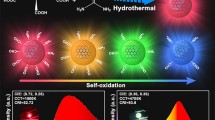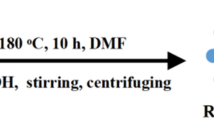Abstract
As a new type of luminescent material, carbon dots (CDs) have attracted increased attention for their superior optical properties in recent years. However, solid-state fluorescent CDs, especially with red emission, are still a major challenge. Here, CDs with solid-state red emission were synthesized by co-doping of N and B using the one-step microwave method. The CD powder exhibits excitation-independent solid-state red fluorescence without any dispersion matrices, with optimum solid-state fluorescence wavelength of 623 nm. The hydrogen bonding interaction in CDs is helpful for solid-state fluorescence of CDs. The IG/ID value of CDs reaches up to 3.49, suggesting their very high graphitization degree, which is responsible for their red emission. In addition, CDs show the concentration-induced multicolor emission, which is attributed to the decreased energy gap in the high concentrated CD solution. To exploit their concentration-dependent emission, CDs with changing ratio in matrices are applied as a color-converting layer on ultraviolet chip to fabricate multicolor light-emitting diodes with light coordinates of (0.33, 0.38), (0.41, 0.48), (0.49, 0.44), and (0.67, 0.33), which belong to green, yellow, orange, and red light, respectively.
Similar content being viewed by others
References
Wang B, Waterhouse G I N, Lu S. Carbon dots: mysterious past, vibrant present, and expansive future. Trends in Chemistry, 2023, 5(1): 76–87
Li S, Li L, Tu H, et al. The development of carbon dots: from the perspective of materials chemistry. Materials Today, 2021, 51: 188–207
Yao B, Huang H, Liu Y, et al. Carbon dots: a small conundrum. Trends in Chemistry, 2019, 1(2): 235–246
Hu C, Li M, Qiu J, et al. Design and fabrication of carbon dots for energy conversion and storage. Chemical Society Reviews, 2019, 48(8): 2315–2337
Wang X F, Wang G G, Li J B, et al. Towards high-powered remote WLED based on flexible white-luminescent polymer composite films containing S, N co-doped graphene quantum dots. Chemical Engineering Journal, 2018, 336: 406–415
Wei Y Y, Chen L, Zhao S B, et al. Green-emissive carbon quantum dots with high fluorescence quantum yield: preparation and cell imaging. Frontiers of Materials Science, 2021, 15(2): 253–265
Yang X, Li X, Wang B, et al. Advances, opportunities, and challenge for full-color emissive carbon dots. Chinese Chemical Letters, 2022, 33(2): 613–625
Wang B, Wei Z, Sui L, et al. Electron-phonon coupling-assisted universal red luminescence of o-phenylenediamine-based carbon dots. Light: Science & Applications, 2022, 11(1): 172
Wang H J, Yu T T, Chen H L, et al. A self-quenching-resistant carbon dots powder with tunable solid-state fluorescence and their applications in light-emitting diodes and fingerprints detection. Dyes and Pigments, 2018, 159: 245–251
Yuan F, Yuan T, Sui L, et al. Engineering triangular carbon quantum dots with unprecedented narrow bandwidth emission for multicolored LEDs. Nature Communications, 2018, 9(1): 2249
Long P, Feng Y, Li Y, et al. Solid-state fluorescence of fluorine-modified carbon nanodots aggregates triggered by poly(ethylene glycol). ACS Applied Materials & Interfaces, 2017, 9(43): 37981–37990
Zhou D, Zhai Y, Qu S, et al. Electrostatic assembly guided synthesis of highly luminescent carbon-nanodots@BaSO4 hybrid phosphors with improved stability. Small, 2017, 13(6): 1602055
Kim T H, Wang F, McCormick P, et al. Salt-embedded carbon nanodots as a UV and thermal stable fluorophore for light-emitting diodes. Journal of Luminescence, 2014, 154: 1–7
Wang J, Zhang F, Wang Y, et al. Efficient resistance against solid-state quenching of carbon dots towards white light emitting diodes by physical embedding into silica. Carbon, 2018, 126: 426–436
Zhou D, Li D, Jing P, et al. Conquering aggregation-induced solid-state luminescence quenching of carbon dots through a carbon dots-triggered silica gelation process. Chemistry of Materials, 2017, 29(4): 1779–1787
Shen C L, Zang J H, Lou Q, et al. In-situ embedding carbon dots in trisodium citrate crystal matrix for tunable solid-state fluorescence. Carbon, 2018, 136: 359–368
Zhu J, Bai X, Chen X, et al. Spectrally tunable solid state fluorescence and room-temperature phosphorescence of carbon dots synthesized via seeded growth method. Advanced Optical Materials, 2019, 7(9): 1801599
Ren J, Stagi L, Innocenzi P. Fluorescent carbon dots in solidstate: from nanostructures to functional devices. Progress in Solid State Chemistry, 2021, 62: 100295
Yan F, Yi C, Hao Z, et al. Solid-state carbon dots with orange phosphorescence and tunable fluorescence via in-situ growth in phthalimide crystal matrix. Colloids and Surfaces A: Physicochemical and Engineering Aspects, 2022, 650: 129626
Wang Z, Yuan F, Li X, et al. 53% Efficient red emissive carbon quantum dots for high color rendering and stable warm white-light-emitting diodes. Advanced Materials, 2017, 29(37): 1702910
Pan L, Sun S, Zhang A, et al. Truly fluorescent excitation-dependent carbon dots and their applications in multicolor cellular imaging and multidimensional sensing Advanced Materials, 2015, 27(47): 7782–7787
Shamsipur M, Barati A, Karami S. Long-wavelength, multicolor, and white-light emitting carbon-based dots: achievements made, challenges remaining, and applications. Carbon, 2017, 124: 429–472
Ba X X, Zhang L, Yin Y L, et al. Luminescent carbon dots with concentration-dependent emission in solution and yellow emission in solid state. Journal of Colloid and Interface Science, 2020, 565: 77–85
Song T, Zhao Y, Matras-Postolek K, et al. Color-tunable carbon dots via control the degree of self-assembly in solution at different concentration. Journal of Luminescence, 2019, 212: 69–75
Qu S, Zhou D, Li D, et al. Toward efficient orange emissive carbon nanodots through conjugated sp2-domain controlling and surface charges engineering. Advanced Materials, 2016, 28(18): 3516–3521
Xu Q, Kuang T, Liu Y, et al. Heteroatom-doped carbon dots: synthesis, characterization, properties, photoluminescence mechanism and biological applications. Journal of Materials Chemistry B: Materials for Biology and Medicine, 2016, 4(45): 7204–7219
Choi Y, Kang B, Lee J, et al. Integrative approach toward uncovering the origin of photoluminescence in dual heteroatom-doped carbon nanodot. Chemistry of Materials, 2016, 28(19): 6840–6847
Liu Y, Li W, Wu P, et al. Hydrothermal synthesis of nitrogen and boron co-doped carbon quantum dots for application in acetone and dopamine sensors and multicolor cellular imaging. Sensors and Actuators B: Chemical, 2019, 281: 34–43
Tian T, He Y, Ge Y, et al. One-pot synthesis of boron and nitrogen co-doped carbon dots as the fluorescence probe for dopamine based on the redox reaction between Cr(VI) and dopamine. Sensors and Actuators B: Chemical, 2017, 240: 1265–1271
Liu W, Zhang R, Kang Y, et al. Preparation of nitrogen-doped carbon dots with a high fluorescence quantum yield for the highly sensitive detection of Cu2+ ions, drawing anti-counterfeit patterns and imaging live cells. New Carbon Materials, 2019, 34(4): 390–402
Jiang L, Ding H, Xu M, et al. UV–vis–NIR full-range responsive carbon dots with large multiphoton absorption cross sections and deep-red fluorescence at nucleoli and in vivo. Small, 2020, 16(19): 2000680
Xu J, Miao Y, Zheng J, et al. Carbon dot-based white and yellow electroluminescent light emitting diodes with a record-breaking brightness. Nanoscale, 2018, 10(23): 11211–11221
Shen C L, Lou Q, Lv C F, et al. Bright and multicolor chemiluminescent carbon nanodots for advanced information encryption. Advanced Science, 2019, 6(11): 1802331
Wei S, Yin X, Li H, et al. Multi-color fluorescent carbon dots: graphitized sp2 conjugated domains and surface state energy level co-modulate band gap rather than size effects. Chemistry, 2020, 26(36): 8129–8136
Yan F, Zhang H, Yu N, et al. Conjugate area-controlled synthesis of multiple-color carbon dots and application in sensors and optoelectronic devices. Sensors and Actuators B: Chemical, 2021, 329: 129263
Miao X, Qu D, Yang D, et al. Synthesis of carbon dots with multiple color emission by controlled graphitization and surface functionalization. Advanced Materials, 2018, 30(1): 1704740
Bourlinos A B, Trivizas G, Karakassides M A, et al. Green and simple route toward boron doped carbon dots with significantly enhanced non-linear optical properties. Carbon, 2015, 83: 173–179
Zhang L, Zhang Z Y, Liang R P, et al. Boron-doped graphene quantum dots for selective glucose sensing based on the “abnormal” aggregation-induced photoluminescence enhancement. Analytical Chemistry, 2014, 86(9): 4423–4430
Zhang M, Wang W, Cui Y, et al. Magnetofluorescent carbon quantum dot decorated multiwalled carbon nanotubes for dual-modal targeted imaging in chemo-photothermal synergistic therapy. ACS Biomaterials Science & Engineering, 2018, 4(1): 151–162
Arcudi F, Dordevic L, Prato M. Rationally designed carbon nanodots towards pure white-light emission. Angewandte Chemie International Edition, 2017, 56(15): 4170–4173
Choi J, Kim N, Oh J W, et al. Bandgap engineering of nanosized carbon dots through electron-accepting functionalization. Journal of Industrial and Engineering Chemistry, 2018, 65: 104–111
Wei Y, Chen L, Wang J, et al. Rapid synthesis of B–N co-doped yellow emissive carbon quantum dots for cellular imaging. Optical Materials, 2020, 100: 109647
Huo B, Liu B, Chen T, et al. One-step synthesis of fluorescent boron nitride quantum dots via a hydrothermal strategy using melamine as nitrogen source for the detection of ferric ions. Langmuir, 2017, 33(40): 10673–10678
Niu X, Song T, Xiong H. Large scale synthesis of red emissive carbon dots powder by solid state reaction for fingerprint identification. Chinese Chemical Letters, 2021, 32(6): 1953–1956
Guo K, Zhang F, Guo S, et al. Achieving red/near-infrared mechanoresponsive luminescence turn-on: mechanically disturbed metastable nanostructures in organic solids. Chemical Communications, 2017, 53(7): 1309–1312
Chandra S, Patra P, Pathan S H, et al. Luminescent S-doped carbon dots: an emergent architecture for multimodal applications. Journal of Materials Chemistry B: Materials for Biology and Medicine, 2013, 1(18): 2375–2382
Zhang Y, Zhuo P, Yin H, et al. Solid-state fluorescent carbon dots with aggregation-induced yellow emission for white light-emitting diodes with high luminous efficiencies. ACS Applied Materials & Interfaces, 2019, 11(27): 24395–24403
Lai S, Jin Y, Shi L, et al. Mechanisms behind excitation- and concentration-dependent multicolor photoluminescence in graphene quantum dots. Nanoscale, 2020, 12(2): 591–601
Shen C, Wang J, Cao Y, et al. Facile access to B-doped solid-state fluorescent carbon dots toward light emitting devices and cell imaging agents. Journal of Materials Chemistry C: Materials for Optical and Electronic Devices, 2015, 3(26): 6668–6675
Ai L, Song Z, Nie M, et al. Solid-state fluorescence from carbon dots widely tunable from blue to deep red through surface ligand modulation. Angewandte Chemie International Edition, 2023, 62(12): e202217822
Zhang F, Feng X, Zhang Y, et al. Photoluminescent carbon quantum dots as a directly film-forming phosphor towards white LEDs. Nanoscale, 2016, 8(16): 8618–8632
Acknowledgements
This work was financially supported by the Foundation Research Project of Shanxi Province (Grant Nos. 202103021223007, 20210302123164, and 20210302124604), the National Natural Science Foundation of China (Grant No. 51972221), the Research Project Supported by Shanxi Scholarship Council of China (Grant Nos. 2020-051 and HGKY2019027), the Scientific and Technological Innovation Programs of Higher Education Institutions in Shanxi (Grant No. 2019L0946), and the Key Research Program of Lyuliang City (Grant No. GXZDYF2019087).
Author information
Authors and Affiliations
Corresponding authors
Additional information
Disclosure of potential conflicts of interests
The authors declare no conflict of interest.
Supplementary Material
11706_2023_648_MOESM1_ESM.pdf
Realization of solid-state red fluorescence and concentration-induced multicolor emission from N, B co-doped carbon dots
Rights and permissions
About this article
Cite this article
Wang, J., Zheng, J., He, P. et al. Realization of solid-state red fluorescence and concentration-induced multicolor emission from N, B co-doped carbon dots. Front. Mater. Sci. 17, 230648 (2023). https://doi.org/10.1007/s11706-023-0648-6
Received:
Accepted:
Published:
DOI: https://doi.org/10.1007/s11706-023-0648-6




